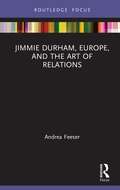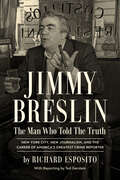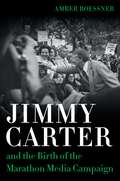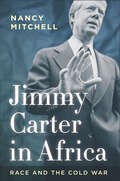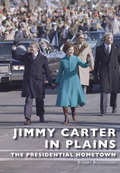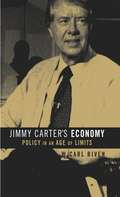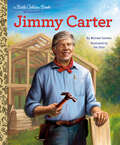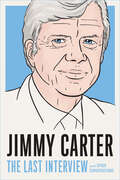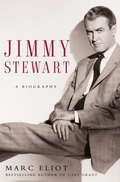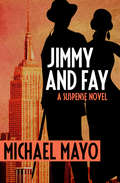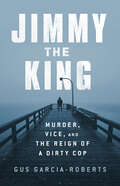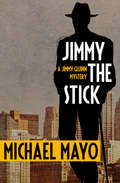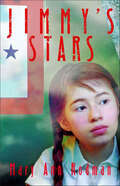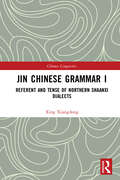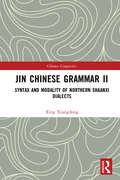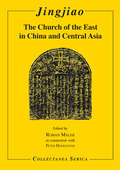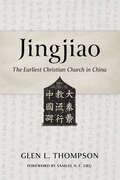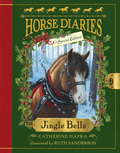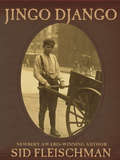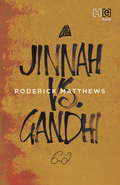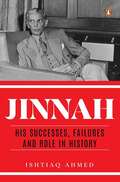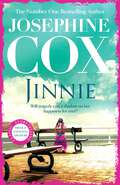- Table View
- List View
Jimmie Durham, Europe, and the Art of Relations (Routledge Focus on Art History and Visual Studies)
by Andrea FeeserThis book investigates Jimmie Durham’s community-building process of making and display in four of his projects in Europe: Something … Perhaps a Fugue or an Elegy (2005); two Neapolitan nativities (2016 and ongoing); The Middle Earth (with Maria Thereza Alves, 2018); and God’s Poems, God’s Children (2017). Andrea Feeser explores these artworks in the context of ideas about connection set forth by writers Ann Lauterbach, Franz Rosenzweig, Pamela Sue Anderson, Vinciane Despret, and Hirokazu Miyazaki, among others. Feeser argues that the materials in Durham’s artworks; the method of their construction; how Durham writes about his pieces; how they exist with respect to one another; and how they address viewers, demonstrate that we can create alongside others a world that embraces and sustains what has been diminished. The book will be of interest to scholars working in contemporary art, animal studies, new materialism research, and eco-criticism.
Jimmie Lee & James
by Steve Fiffer Ardar CohenIn the early months of 1965, the killings of two civil rights activists inspired the Selma-to-Montgomery marches, which became the driving force behind the passage of the Voting Rights Act. This is their story."Bloody Sunday"--March 7, 1965--was a pivotal moment in the civil rights struggle. The national outrage generated by scenes of Alabama state troopers attacking peaceful demonstrators fueled the drive toward the passage of the Voting Rights Acts later that year. But why were hundreds of activists marching from Selma to Montgomery that afternoon? Days earlier, during the crackdown on another protest in nearby Marion, a state trooper, claiming self-defense, shot Jimmie Lee Jackson, a 26-year-old unarmed deacon and civil rights protester. Jackson's subsequent death spurred local civil rights leaders to make the march to Montgomery; when that day also ended in violence, the call went out to activists across the nation to join in the next attempt. One of the many who came down was a minister from Boston named James Reeb. Shortly after his arrival, he was attacked in the street by racist vigilantes, eventually dying of his injuries. Lyndon Johnson evoked Reeb's memory when he brought his voting rights legislation to Congress, and the national outcry over the brutal killings ensured its passage. Most histories of the civil rights movement note these two deaths briefly, before moving on to the more famous moments. Jimmie Lee and James is the first book to give readers a deeper understanding of the events that galvanized an already-strong civil rights movement to one of its greatest successes, along with the herculean efforts to bring the killers of these two men to justice--a quest that would last more than four decades.he historic 1965 voting rights march from Selma to Montgomery. A well-written, well-reported page-turner about our collective struggle for equality and justice . . . hopefully the last chapter in the American Revolution."--Morris Dees, Founder of the Southern Poverty Law Center "Jimmie Lee and James does an excellent job of chronicling a truly American movement. As the book so clearly explains, this was a struggle led by African Americans, but white Americans played a major role. Jews and other denominations added institutional support from every part of America. We suffered and sometimes died together." --Civil rights activist, Rev. C. T. Vivian
Jimmy Breslin: The Man Who Told the Truth
by Richard Esposito“Do not. Confuse me. With. The facts. I tell the truth.” —Jimmy Breslin The first-ever biography of America’s greatest crime reporter In a newspaper career spanning decades, Jimmy Breslin covered the stories that he knew mattered most: the human stories beyond the front page. From the JFK assassination, to the Son of Sam killings, mafia heists, the Crown Heights riots, and the Occupy movement, Breslin’s influential columns captured the lifebeat of the second half of the 20th century. A quintessential New Yorker, Breslin rubbed shoulders with world leaders and neighborhood arsonists, profiled JFK’s gravedigger, and elicited letters from the Son of Sam killer during his reign of terror, all recounted in columns that were personal, blunt, and the truth—at least Jimmy’s version of it. Jimmy Breslin: The Man Who Told the Truth is the first biography of the legendary writer, vividly portrayed by Richard Esposito, a former colleague of the Big Man. From Breslin’s humble beginnings as a copy boy, to winning the 1986 Pulitzer Prize for Commentary, the writer’s life was as fascinating as any of his subjects. With the full cooperation of Breslin’s family and interviews with countless of his former coworkers, friends, and enemies, Esposito has crafted a meticulous and revealing portrait of a complex man who bared his soul to the world in column inches.
Jimmy Carter and the Birth of the Marathon Media Campaign (Media and Public Affairs)
by Amber RoessnerWith the rise of Jimmy Carter, a former Georgia governor and a relative newcomer to national politics, the 1976 presidential election proved a transformative moment in U.S. history, heralding a change in terms of how candidates run for public office and how the news media cover their campaigns.Amber Roessner’s Jimmy Carter and the Birth of the Marathon Media Campaign chronicles a change in the negotiation of political image-craft and the role it played in Carter’s meteoric rise to the presidency. She contends that Carter’s underdog victory signaled a transition from an older form of party politics focused on issues and platforms to a newer brand of personality politics driven by the manufacture of a political image.Roessner offers a new perspective on the production and consumption of media images of the peanut farmer from Plains who became the thirty-ninth president of the United States. Carter’s miraculous win transpired in part because of carefully cultivated publicity and advertising strategies that informed his official political persona as it evolved throughout the Democratic primary and general-election campaigns. To understand how media relations helped shape the first post-Watergate presidential election, Roessner examines the practices and working conditions of the community of political reporters, public relations agents, and advertising specialists associated with the Carter bid. She draws on materials from campaign files and strategic memoranda; radio and TV advertisements; news and entertainment broadcasts; newspaper and magazine coverage; and recent interviews with Carter, prominent members of his campaign staff, and over a dozen journalists who reported on the 1976 election and his presidency.With its focus on the inner workings of the bicentennial election, Jimmy Carter and the Birth of the Marathon Media Campaign offers an incisive view of the transition from the yearlong to the permanent campaign, from New Deal progressivism to New Right conservatism, from issues to soundbites, and from objective news analysis to partisan commentary.
Jimmy Carter in Africa: Race and the Cold War (Cold War International History Project)
by Nancy MitchellIn the mid-1970s, the Cold War had frozen into a nuclear stalemate in Europe and retreated from the headlines in Asia. As Gerald Ford and Jimmy Carter fought for the presidency in late 1976, the superpower struggle overseas seemed to take a backseat to more contentious domestic issues of race relations and rising unemployment. There was one continent, however, where the Cold War was on the point of flaring hot: Africa. Jimmy Carter in Africa opens just after Henry Kissinger's failed 1975 plot in Angola, as Carter launches his presidential campaign. The Civil Rights Act was only a decade old, and issues of racial justice remained contentious. Racism at home undermined Americans' efforts to "win hearts and minds" abroad and provided potent propaganda to the Kremlin. As President Carter confronted Africa, the essence of American foreign policy--stopping Soviet expansion--slammed up against the most explosive and raw aspect of American domestic politics--racism. Drawing on candid interviews with Carter, as well as key U.S. and foreign diplomats, and on a dazzling array of international archival sources, Nancy Mitchell offers a timely reevaluation of the Carter administration and of the man himself. In the face of two major tests, in Rhodesia and the Horn of Africa, Carter grappled with questions of Cold War competition, domestic politics, personal loyalty, and decision-making style. Mitchell reveals an administration not beset by weakness and indecision, as is too commonly assumed, but rather constrained by Cold War dynamics and by the president's own temperament as he wrestled with a divided public and his own human failings. Jimmy Carter in Africa presents a stark portrait of how deeply Cold War politics and racial justice were intertwined.
Jimmy Carter in Plains: The Presidential Hometown (Images of Modern America)
by Robert BuccellatoThe physical connections to most American presidents are deeply rooted in the past and unfamiliar. One can no longer see Washington's birthplace or William Henry Harrison's log cabin. Plains, Georgia, is different, and the attachment Americans have for it remains truly unique. Jimmy Carter in Plains: A Presidential Hometown tells the inspirational story of how one man and his community transformed a nation. When Jimmy Carter, a one-term governor of Georgia, announced his candidacy for president, few took him seriously. Yet, in just two years, he managed to pull off a spectacular and unprecedented victory, thanks to his personal style of politicking and the support of his hometown. Many of his neighbors campaigned for him, and they became known as the "Peanut Brigade." Crowds started to flock to the sleepy hamlet of Plains, making celebrities out of the candidate's mother, younger brother, and daughter. The exceptional photographs of Charles W. Plant guide the reader through the 1976 election, which made Plains "America's hometown."
Jimmy Carter's Economy: Policy in an Age of Limits
by W. Carl BivenThe massive inflation and oil crisis of the 1970s damaged Jimmy Carter's presidency. In Jimmy Carter's Economy, Carl Biven traces how the Carter administration developed and implemented economic policy amid multiple crises and explores how a combination of factors beyond the administration's control came to dictate a new paradigm of Democratic Party politics. Jimmy Carter inherited a deeply troubled economy. Inflation had been on the rise since the Johnson years, and the oil crisis Carter faced was the second oil price shock of the decade. In addition, a decline in worker productivity and a rise in competition from Germany and Japan compounded the nation's economic problems. The resulting anti-inflation policy that was forced on Carter included controlling public spending, limiting the expansion of the welfare state, and postponing popular tax cuts. Moreover, according to Biven, Carter argued that the ambitious policies of the Great Society were no longer possible in an age of limits and that the Democratic Party must by economic necessity become more centrist.
Jimmy Carter: A Little Golden Book Biography (Little Golden Book)
by Michael JoostenHelp your little one dream big with a Little Golden Book biography about Jimmy Carter—small town peanut farmer who became the 39th president of the United States! The perfect introduction to nonfiction for young readers—as well as fans of all ages!This Little Golden Book about Jimmy Carter—the 39th president of the United States and Nobel Peace Prize recipient from Plains, Georgia, who continued to help people well into his nineties by building houses with Habitat for Humanity—is an inspiring read-aloud for young girls and boys. Look for more Little Golden Book biographies:George W. BushJohn McCainRonald ReaganBarack ObamaJoe Biden
Jimmy Carter: and Other Conversations (The Last Interview Series)
by Melville House&“We can choose to alleviate suffering. We can choose to work together for peace. We can make these changes—and we must.&” —Jimmy CarterJames Earl Carter Jr. came from a background of farming and military service to forge an unlikely political career, first as governor of Georgia, and then as the 39th president of the United States.The interviews collected here—four of them never published in book form before—span the arc of Carter&’s long career as a politician, a public servant, and a citizen diplomat. They range from an early joust with conservative commentator William F. Buckley Jr. to his final interview, a moving joint conversation with his wife Rosalynn on the occasion of their 75th wedding anniversary … and, of course, it includes the notorious 1976 Playboy interview wherein Carter remarked that he had &“committed adultery in my heart many times.&”The result is a fascinating look into the mind and soul of one of our most admirable and principled presidents ever.
Jimmy Stewart: A Biography
by Marc EliotJimmy Stewart's all-American good looks, boyish charm, and deceptively easygoing style of acting made him one of Hollywood's greatest and most enduring stars. Despite the indelible image he projected of innocence and quiet self-assurance, Stewart's life was more complex and sophisticated than most of the characters he played. With fresh insight and unprecedented access, bestselling biographer Marc Eliot finally tells the previously untold story of one of our greatest screen and real-life heroes. Born into a family of high military honor and economic success dominated by a powerful father, Stewart developed an interest in theater while attending Princeton University. Upon graduation, he roomed with the then-unknown Henry Fonda, and the two began a friendship that lasted a lifetime. While he harbored a secret unrequited love for Margaret Sullavan, Stewart was paired with many of Hollywood's most famous, most beautiful, and most alluring leading ladies during his extended bachelorhood, among them Ginger Rogers, Olivia de Havilland, Loretta Young, and the notorious Marlene Dietrich. After becoming a star playing a hero in Frank Capra's Mr. Smith Goes to Washington in 1939 and winning an Academy Award the following year for his performance in George Cukor's The Philadelphia Story, Stewart was drafted into the Armed Forces and became a hero in real life. When he returned to Hollywood, he discovered that not only the town had changed, but so had he. Stewart's combat experiences left him emotionally scarred, and his deepening darkness perfectly positioned him for the '50s, in which he made his greatest films, for Anthony Mann (Winchester '73 and Bend of the River) and, most spectacularly, Alfred Hitchcock, in his triple meditation on marriage, Rear Window, The Man Who Knew Too Much, and Vertigo, which many film critics regard as the best American movie ever made. While Stewart's career thrived, so did his personal life. A marriage in his forties, the adoption of his wife's two sons from a previous marriage, and the birth of his twin daughters laid the foundation for a happy life, until an unexpected tragedy had a shocking effect on his final years. Intimate and richly detailed, Jimmy Stewart is a fascinating portrait of a multi-faceted and much-admired actor as well as an extraordinary slice of Hollywood history. "Probably the best actor who's ever hit the screen." --Frank Capra. "He taught me that it was possible to remain who you are and not be tainted by your environment. He was not an actor ... he was the real thing." --Kim Novak. "He was uniquely talented and a good friend." --Frank Sinatra. "He was a shy, modest man who belonged to cinema nobility." --Jack Valenti. "There is nobody like him today." --June Allyson. "He was one of the nicest, most unassuming persons I have known in my life. His career speaks for itself." --Johnny Carson.
Jimmy and Fay: A Suspense Novel
by Michael MayoIn the midst of Prohibition, Jimmy Quinn joins forces with screen siren Fay Wray to take on a King Kong-size case of extortion. It's March 2, 1933. King Kong is premiering at Radio City Music Hall, and Fay Wray is about to become the most famous actress on earth. So what's she doing hanging around a rundown Manhattan speakeasy? This Hollywood scream queen has come to see Jimmy Quinn, a limping tough guy who knows every gangster in New York--and does his best to steer clear of them all. A blackmailer has pictures of a Fay Wray lookalike engaged in conduct that would make King Kong blush, and Fay's movie studio--with the cooperation of a slightly corrupt NYPD detective--wants the threat eliminated. Jimmy tries to settle the matter quietly, but stopping the extortion will cut just as deeply as Fay's famous scream, ringing from Broadway all the way to Chinatown. Jimmy and Fay is the 3rd book in the Jimmy Quinn Mysteries, but you may enjoy reading the series in any order.
Jimmy the King: Murder, Vice, and the Reign of a Dirty Cop
by Gus Garcia-RobertsAn incredible four-decade account of murder, power, and corruption in one of the country&’s largest police departments In 1979, the gruesome slaying of a thirteen-year-old boy riveted the suburbs of Suffolk County, New York. As the county hustled to bring the case to a dubious resolution, a wayward local teenager emerged with a convenient story to tell. For his cooperation, James Burke was rewarded with a job as a cop. Thus began Burke&’s unlikely ascent to the top of one of the country&’s largest law enforcement jurisdictions. He and a crew of likeminded allies utilized vengeance, gangster tactics, and political leverage to become the most powerful and feared figures in their suburban empire. In his quest to maintain that power, Burke botched -- intentionally or not -- dire investigations like that of the famed Gilgo Beach serial killings and the county's MS-13 gang scourge. Until a pilfered bag of sex toys brought it all crashing down.Jimmy the King is the story of the rise, reign, and paranoiac fall of a corrupt cop and his regime—a crime family with badges and guaranteed pensions. Novelistic in detail and piercing in its political insight, this book will leave you questioning who modern policing serves, who it protects, and who it preys upon and abandons.
Jimmy the Stick
by Michael MayoA gunman comes out of retirement to guard his former partner's familyJimmy Quinn was a gunman, bootlegger, and bagman, running with mobsters the likes of Lucky Luciano, Meyer Lansky, and Vincent "Mad Dog" Coll, until a bullet in the leg and the murder of Arnold Rothstein ended his career. Quinn bought a speakeasy in downtown Manhattan and settled into a quiet retirement--until the day he learns that famous aviator Charles Lindbergh's baby has been kidnapped, and his old friend and partner Walter Spencer wants a word. Spence has left his criminal past behind, marrying into the Pennyweight family--of Pennyweight Petroleum--and settling into a legitimate lifestyle in rural New Jersey. Now Spence has business out of state, and with the Lindbergh kidnapping weighing on his mind, he wants Quinn to stay in his home and protect his family. A few days guarding Spence's beautiful wife should be easy work, but Quinn's old business is about to catch up with him, and he quickly finds that the Garden State can be even more dangerous than the streets of New York City.
Jimmy the Stick
by Michael MayoA gunman comes out of retirement to guard his former partner's familyJimmy Quinn was a gunman, bootlegger, and bagman, running with mobsters the likes of Lucky Luciano, Meyer Lansky, and Vincent "Mad Dog" Coll, until a bullet in the leg and the murder of Arnold Rothstein ended his career. Quinn bought a speakeasy in downtown Manhattan and settled into a quiet retirement--until the day he learns that famous aviator Charles Lindbergh's baby has been kidnapped, and his old friend and partner Walter Spencer wants a word. Spence has left his criminal past behind, marrying into the Pennyweight family--of Pennyweight Petroleum--and settling into a legitimate lifestyle in rural New Jersey. Now Spence has business out of state, and with the Lindbergh kidnapping weighing on his mind, he wants Quinn to stay in his home and protect his family. A few days guarding Spence's beautiful wife should be easy work, but Quinn's old business is about to catch up with him, and he quickly finds that the Garden State can be even more dangerous than the streets of New York City.
Jimmy's Stars
by Mary Ann RodmanIt's September 1943, and eleven-year-old Ellie McKelvey's older brother, Jimmy, has just been drafted. Jimmy has a joyful heart and a kind word for everyone, and he's the only person who thinks Ellie is smart and funny and as beautiful as Lana Turner, the movie star. Ellie can hardly stand to see him go. With Jimmy gone, Aunt Toots moves into his bedroom, Ellie's mother takes a war job at a factory, and everything in Ellie's life seems upside down. But she figures that the war will be over and Jimmy home by Christmas, so as much as she misses him, she keeps her spirits up. Even as families in the neighborhood begin to receive telegrams informing them that their boys are wounded or worse, Ellie never stops believing in Jimmy. In her second work of historical fiction, Mary Ann Rodman captures all the authentic details of life on the homefront during World War II, as well as the fierce love a sister has for her beloved big brother.Jimmy's Stars is a 2009 Bank Street - Best Children's Book of the Year.
Jin Chinese Grammar I: Referent and Tense of Northern Shaanxi Dialects (Chinese Linguistics)
by Xing XiangdongThis book is the first volume of a two-volume set that synchronically and diachronically studies the Jin dialect of Northern Shaanxi Province in China, with a focus on the grammatical features of pronouns, aspect and appearance, and the system of tenses. The Jin dialect of Northern Shaanxi is one of the most ancient, complicated, and representative dialects of the Yellow River region and figures prominently in our understanding of the Jin dialect and northern Chinese dialects as a whole. This volume first elucidates the semantic and dialectal differences in personal pronouns, demonstrative pronouns, and interrogative pronouns, as well as the special linguistic origins of the pronouns. The following chapter elaborates the different devices to express the status of realizing, accomplishing, lasting, and momentum-reducing as well as differences among similar aspectual markers and dialects. The final chapter examines the tense system, including anterior (past), posterior (future), and simple (present) tenses, the markers of which differ from each other in their syntactic representations.The book will be a useful reference for scholars and students interested in Jin dialects, Chinese dialects, and Chinese linguistics.
Jin Chinese Grammar II: Syntax and Modality of Northern Shaanxi Dialects (Chinese Linguistics)
by Xing XiangdongThis book is the second volume of a two-volume set that synchronically and diachronically studies the Jin dialect of Northern Shaanxi Province in China, with a focus on six grammatical features of the dialect.The Jin dialect of Northern Shaanxi is one of the most ancient, complicated, and representative dialects of the Yellow River region and figures prominently in our understanding of the Jin dialect and northern Chinese dialects as a whole. The book looks into the following six aspects of the dialect: subjunctive mood, expressions of complex sentence relationships, embedded sentence patterns, complex interrogative sentences, the formation of imperative modal particle “zhe”, and the phonetic variation of grammatical constituents. In the final chapter, the author discusses the significance of diachronic comparison as the research method for studying Chinese dialectal grammar.The book will be a useful reference for scholars and students interested in Jin dialects, Chinese dialects, and Chinese linguistics.
Jingjiao: The Church of the East in China and Central Asia (Collectanea Serica)
by Roman MalekThe contributions in this volume were mostly first presented at the conference "Research on Nestorianism in China. Zhongguo jingjiao yanjiu 中國景教研究" held in Salzburg, 20– 26 May 2003. Like the conference, the volume explores the subject of "Nestorianism" (jingjiao, "Luminous Religion") in a variety of aspects. The material of the present collection is organized in five parts. The first part presents different aspects of the past and current research on jingjiao. The second part discusses jingjiao in the Tang dynasty, especially the question of the "Nestorian" texts and documents, their authenticity and theology. The third part deals with the "Nestorian" inscriptions and remains from the Yuan dynasty, especially from Quanzhou. Part four is dedicated to questions of the Church of the East in Central Asia and other historically relevant countries. The last part of the book presents a "Preliminary Bibliography on the Church of the East in China and Central Asia" prepared especially for this volume.
Jingjiao: The Earliest Christian Church in China
by Glen L. ThompsonChristianity Today Award of Merit in History/Biography (2025)A balanced, accessible, and thorough history of Jingjiao, the first Christian church in China Many people assume that the first introduction of Christianity to the Chinese was part of nineteenth-century Western imperialism. In fact, Syriac-speaking Christians brought the gospel along the Silk Road into China in the seventh century. Glen L. Thompson introduces readers to the fascinating history of this early Eastern church, referred to as Jingjiao, or the &“Luminous Teaching.&” Thompson presents the history of the Persian church&’s mission to China with rigor and clarity. While Christianity remained a minority and &“foreign&” religion in the Middle Kingdom, it nonetheless attracted adherents among indigenous Chinese and received imperial approval during the Tang Dynasty. Though it was later suppressed alongside Buddhism, it resurfaced in China and Mongolia in the twelfth century. Thompson also discusses how the modern unearthing of Chinese Christian texts has stirred controversy over the meaning of Jingjiao to recent missionary efforts in China. In an accessible style, Thompson guides readers through primary sources as well as up-to-date scholarship. As the most recent and balanced survey on the topic available in English, Jingjiao will be an indispensable resource for students of global Christianity and missiology.
Jingle Bells (Horse Diaries Special Edition)
by Catherine Hapka Ruth SandersonA heartwarming Clydesdale story for the holiday season! For all lovers of horses, history, and the holidays, here's a very special Horse Diaries book. Wisconsin, 1915. Jingle Bells is a strong Clydesdale gelding. He enjoys his work on the farm, pulling the hay wagon in the summer and a sleigh in the winter, and he loves his human friend, Kari. But when Kari's older brother comes home for Christmas with a new Model T Ford, will the family still need Jingle Bells?
Jingo Django
by Sid FleischmanOrphan Jingo Hawks is out of luck when Mrs. Daggatt hires him out as a chimney sweep to the awful General Dirty-Face Scurlock. But it's gypsy luck that day in 1854 puts Jingo into the right chimney and then into the care of the mysterious Mr. Peacock-Hancock-Jones, who claims to know Jingo's scoundrel father. Together they set out on a treasure hunt from Boston to Mexico for buried gold. But they are not alone -- those nasty gold diggers Mrs. Daggatt and General Scurlock are hot on their trail. But Mr. Peacock-Hancock-Jones has more than a few surprises in store . . .
Jinnah vs. Gandhi
by Roderick MatthewsThe modern history of South Asia is shaped by the personalities of its two most prominent politicians and ideologues ? Mohammad Ali Jinnah and Mahatma Gandhi. Jinnah shaped the final settlement by consistently demanding Pakistan, and Gandhi defined the largely non-violent nature of the campaign. Each made their contribution by taking over and refashioning a national political party, which they came to personify. Theirs would seem, therefore, to be a story of success, yet for each of them, the story ended in a kind of failure. How did two educated barristers who saw themselves as heralds of a newly independent country come to find themselves on opposite ends of the political spectrum? How did Jinnah, who started out a secular liberal, end up a Muslim nationalist? How did a God-fearing moralist and social reformer like Gandhi become a national political leader? And how did their fundamental divergences lead to the birth of two new countries that have shaped the political history of the subcontinent? This book skilfully chronicles the incredible similarities and ultimate differences between the two leaders, as their admirers and detractors would have it and as they actually were.'
Jinnah: His Successes, Failures and Role in History
by Ishtiaq AhmedMohammad Ali Jinnah has been both celebrated and reviled for his role in the Partition of India, and the controversies surrounding his actions have only increased in the seven decades and more since his death. Ishtiaq Ahmed places Jinnah's actions under intense scrutiny to ascertain the Quaid-i-Azam's successes and failures and the meaning and significance of his legacy. Using a wealth of contemporary records and archival material, Dr Ahmed traces Jinnah's journey from Indian nationalist to Muslim communitarian, and from a Muslim nationalist to, finally, Pakistan's all-powerful head of state. How did the ambassador of Hindu-Muslim unity become the inflexible votary of the two-nation theory? Did Jinnah envision Pakistan as a theocratic state? What was his position on Gandhi and federalism? Asking these crucial questions against the backdrop of the turbulent struggle against colonialism, this book is a path-breaking examination of one of the most controversial figures of the twentieth century.
Jinnie: A compelling saga of love, betrayal and belonging
by Josephine CoxA ten-year-old tragedy casts a dangerous shadow on the happiness of two families... In Jinnie, the sequel to The Woman Who Left, Josephine Cox weaves an unforgettable saga of the lingering power of past betrayals. Perfect for fans of Rosie Goodwin and Dilly Court.'If you are looking for a story with warmth, humanity and more then a touch of grit, you need look no further... warm and compelling family saga which is as welcome as a roaring fire on a freezing winter's day... never a moment when you are not put in touch with the passions of life' - The Northern EchoTen years ago, Louise Hunter's life was torn apart by tragedy. Her husband, Ben, killed himself; her brother-in-law, Jacob, was murdered; and her sister, Susan, abandoned her new-born daughter, revealing the baby is Ben's child. Louise remains haunted by guilt over the one night she spent with Ben's friend Eric, and refuses to return Eric's love. But after adopting Jinnie, she finds new happiness - until Susan decides she wants Jinnie back.Meanwhile, Adam and Hannah, whose mother was killed with Jacob, are on the run. What Adam witnessed on that dreadful night has put them all in danger, but their beloved grandmother knows that one day they must return to the place where it all began...What readers are saying about Jinnie: 'Kept me absolutely gripped from beginning to end - the kind of books that make you feel really sad when you come to the end and leave you wishing they could just go on and on''Super story, could not guess the ending - five stars'
Jinnie: A compelling saga of love, betrayal and belonging
by Josephine CoxA ten-year-old tragedy casts a dangerous shadow on the happiness of two families... In Jinnie, the sequel to The Woman Who Left, Josephine Cox weaves an unforgettable saga of the lingering power of past betrayals. Perfect for fans of Rosie Goodwin and Dilly Court.'If you are looking for a story with warmth, humanity and more then a touch of grit, you need look no further... warm and compelling family saga which is as welcome as a roaring fire on a freezing winter's day... never a moment when you are not put in touch with the passions of life' - The Northern EchoTen years ago, Louise Hunter's life was torn apart by tragedy. Her husband, Ben, killed himself; her brother-in-law, Jacob, was murdered; and her sister, Susan, abandoned her new-born daughter, revealing the baby is Ben's child. Louise remains haunted by guilt over the one night she spent with Ben's friend Eric, and refuses to return Eric's love. But after adopting Jinnie, she finds new happiness - until Susan decides she wants Jinnie back.Meanwhile, Adam and Hannah, whose mother was killed with Jacob, are on the run. What Adam witnessed on that dreadful night has put them all in danger, but their beloved grandmother knows that one day they must return to the place where it all began... What readers are saying about Jinnie: 'Kept me absolutely gripped from beginning to end - the kind of books that make you feel really sad when you come to the end and leave you wishing they could just go on and on''Super story, could not guess the ending - five stars'
